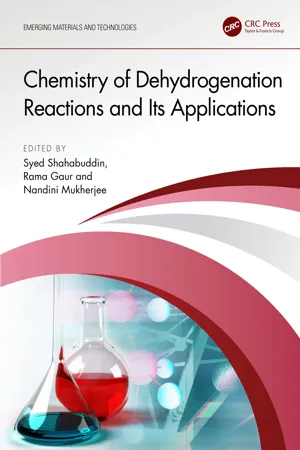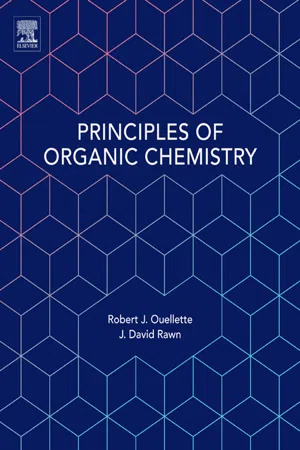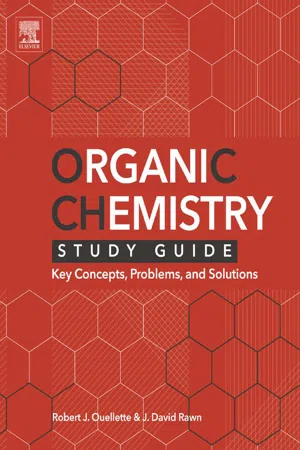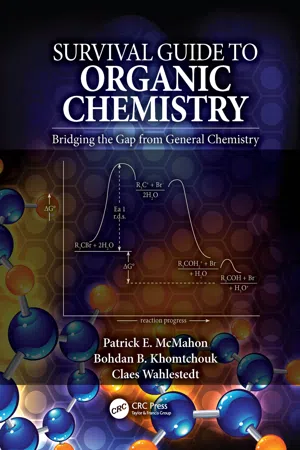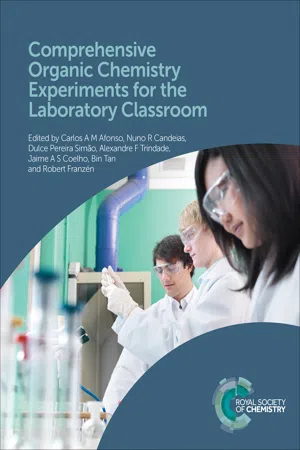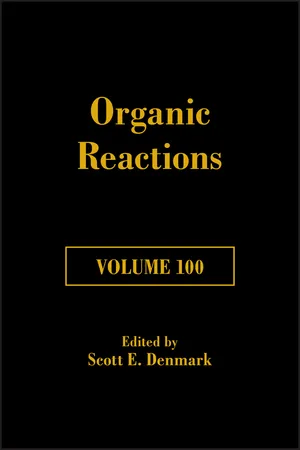Chemistry
Dehydrohalogenation of Alkyl Halides
Dehydrohalogenation of alkyl halides is a chemical reaction in which a hydrogen halide is removed from an alkyl halide, resulting in the formation of an alkene. This process typically involves the use of a strong base to abstract the acidic hydrogen from the alkyl halide, leading to the formation of a carbon-carbon double bond. Dehydrohalogenation is an important method for synthesizing alkenes in organic chemistry.
Written by Perlego with AI-assistance
Related key terms
Related key terms
1 of 4
Related key terms
1 of 3
8 Key excerpts on "Dehydrohalogenation of Alkyl Halides"
- Syed Shahabuddin, Rama Gaur, Nandini Mukherjee(Authors)
- 2024(Publication Date)
- CRC Press(Publisher)
1 Introduction to Dehydrogenation Reactions of Organic CompoundsSyed Shahabuddin, Nandini Mukherjee, and Rama GaurDOI: 10.1201/9781003321934-11.1 INTRODUCTION
Dehydrogenation reactions include a wide variety of reactions where hydrogen is completely or partially eliminated from an organic compound to form a new compound (e.g., conversion of saturated into unsaturated compounds) [1 ]. Dehydrogenation reactions have applications in the production of hydrogen (H2 ), alkenes, cycloalkanes, aromatic compounds, imines, and oxygenates such as carbonyl compounds [2 ]. Alkenes, imines, and oxygenates are crucial chemical intermediates for producing solvents, polymers, rubbers, detergents, insecticides, and pharmaceuticals [3 ].Dehydrogenation is most important in the petrochemical industry especially in the refinery cracking process, where olefins are synthesized from saturated hydrocarbons [4 ]. Suitable hydrocarbon feed-stocks (e.g., naphtha) are subjected to cracking in order to produce industrially important olefins such as ethylene, propylene, butene derivatives, and butadiene derivatives in large volumes. Traditionally, steam cracking and fluid catalytic cracking (FCC) of C2+ hydrocarbons (ethane, propane, etc.) have been extensively used to produce alkenes. However, as there is an increasing demand for a specific alkene to be produced, building new specific steam crackers or FCC units for each individual alkene is not a frugal choice. Dehydrogenation reaction, in contrast, provides a comparatively flexible, cost-effective method for producing single alkenes. The dehydrogenation of ethylbenzene to produce an important monomer ‘styrene’ has become a preferred commercial route in the polymer industry.The benefits of building dehydrogenation reactors are the production not only of specific alkenes but also of aldehydes and ketones. Although the carbonyl compounds can be easily prepared via the oxidation of alkenes or alcohols, dehydrogenation routes may offer advantages such as a higher selectivity for products or the availability of a wider variety of feedstock [5 ]. Dehydrogenation reaction is also extremely useful in synthesizing α,β-unsaturated carbonyls as common organic building blocks in natural product and pharmaceutical synthesis. The introduction of a C=C group adjacent to an electron withdrawing group (EWG) provides greater synthetic opportunity that utilizes the resulting polarized double bond, since EWG is susceptible to regioselective functionalization by several methods [6 , 7 ]. Acceptorless dehydrogenation of alcohols, especially biomass-derived carbohydrates, provides an atom-economical method to synthesize carbonyl derivatives and a low-temperature route for selective H2 production [8 –14 ]. It also has synthetic applications in tandem coupling reactions involving C-N and C-C bond formation for the synthesis of imines and amides and the β-functionalization of alcohols [15 –24- eBook - ePub
- Andrew F. Parsons(Author)
- 2013(Publication Date)
- Wiley(Publisher)
5 Br.- An alicyclic halogenoalkane has the carbon atoms in a closed ring, but the ring is not aromatic, e.g. bromocyclohexane, C6 H11 Br.
- An aromatic halogenoalkane has the carbon atoms in a closed ring and the ring is aromatic, e.g. bromobenzene, C6 H5 Br.
The formation of bromobenzene from benzene is discussed in Section 7.2.15.2 Preparation
5.2.1 Halogenation of Alkanes
Chloroalkanes (RCl) or bromoalkanes (RBr) can be obtained from alkanes (RH) by reaction with chlorine or bromine gas, respectively, in the presence of UV radiation. The reaction involves a radical chain mechanism.Radicals are introduced in Section 4.1 Radical reactions are discussed in Section 4.6.2This is a substitution reaction as a hydrogen atom on the carbon is substituted for a Cl or Br atom. A mixture of halogenated products is usually obtained if further substitution reactions can take place.Chloroalkanes, such as CH2 Cl2 (dichloromethane), are common solvents in organic synthesisPrimary, secondary and tertiary halogenoalkanes are defined in Section 2.1The ease of halogenation depends on whether the hydrogen atom is bonded to a primary, secondary or tertiary carbon atom. A tertiary hydrogen atom is more reactive because reaction with a halogen atom (X• ) produces an intermediate tertiary radical, which is more stable (and therefore more readily formed) than a secondary or primary radical (Section 4.3).5.2.2 Halogenation of Alcohols
Alcohols (ROH) are converted into halogenoalkanes using a number of methods. All methods involve ‘activating’ the OH group to make this into a better leaving group (Section 5.3.1.4). Reaction mechanisms are introduced in Section 4.11The mechanism of these reactions depends on whether a primary (RCH2 OH), secondary (R2 CHOH) or tertiary alcohol (R3 - eBook - ePub
- Robert J. Ouellette, J. David Rawn(Authors)
- 2015(Publication Date)
- Elsevier(Publisher)
7Nucleophilic Substitution and Elimination Reactions
7.1 Reaction Mechanisms and Haloalkanes
We introduced the concept of functional groups and their role in the organization of the structures of organic molecules in Section 1.9 . We described the importance of reaction mechanisms as an organizational device to classify chemical reactions in Section 2.9 . The details of the electrophilic addition reactions of alkenes (Section 4.9 ) and electrophilic substitution reactions of aromatic compounds (Section 5.5 ) are examples of two important reaction mechanisms. In this chapter we examine two more types of reactions mechanisms—nucleophilic substitution and elimination reactions. These mechanisms often occur in competition with one another and describe the reactions of several classes of compounds, such as haloalkanes (also called alkyl halides) and alcohols. In this chapter we focus on the substitution and elimination reactions of haloalkanes. These reactions illustrate the role of structure in determining the degree to which a given reaction mechanisms occurs.Reactivity of Haloalkanes
Haloalkanes have a halogen atom bonded to an sp3 -hybridized carbon atom. As a result of the greater electronegativity of the halogens, the carbon atom of the carbon-halogen bond bears a partial positive charge and the halogen atom has a partial negative charge.where X = F, Cl, Br, ISince a carbon-halogen bond is polar, a haloalkane has two sites of reactivity. One is at the carbon atom bonded to the halogen atom. This carbon atom is electropositive and reacts with nucleophiles. The second site of reactivity in a haloalkane is the hydrogen atom bonded to the carbon atom adjacent to the carbon atom bonded to the halogen atom. This hydrogen atom is more acidic than the hydrogen atoms in alkanes because the halogen atom on the adjacent carbon atom withdraws electron density by an inductive effect. - eBook - ePub
Organic Chemistry Study Guide
Key Concepts, Problems, and Solutions
- Robert J. Ouellette, J. David Rawn(Authors)
- 2014(Publication Date)
- Elsevier(Publisher)
Since undesirable rearrangements occur in acid-catalyzed reactions of alcohols, other methods have been developed to synthesize alcohols that do not require acid. In this section, we discussed two additional reagents that convert alcohols to haloalkanes. They are used for secondary and primary alcohols which react slowly with hydrogen halides.Thionyl chloride is used to convert alcohols to chloroalkanes. The by-products are sulfur dioxide and hydrogen chloride, both of which escape from the solution as gases. Phosphorus tribromide is used to convert alcohols to bromoalkanes. The by-product, phosphorous acid, is soluble in water.9.14 Elimination Reactions
The elimination reactions we consider result in loss of atoms from adjacent carbon atoms and is called a 1,2-elimination or a (β-elimination). β-Elimination reactions occur by either E1 or E2 mechanisms. An E1 mechanism is similar to an SN 1 mechanism in one key respect: it is a unimolecular reaction in which a carbocation intermediate forms in the rate determining step. And, as in SN 1 reactions, the carbocation can, and often does, rearrange to give several products. E1 reactions typically occur in the dehydration of tertiary alcohols. E1 reactions compete with SN 1 reactions. E2 reactions, like SN 2 reactions, are bimolecular processes in which there are two species in the transition state. E2 reactions are observed for primary and secondary alkyl halides and alcohols. The reactions of alcohols in both E1 and E2 reactions are acid catalyzed.9.15 Regioselectivity in Dehydrohalogenation
Dehydrohalogenaton occurs to give a predominance of the most substituted alkene. This regioselectivity results in the so-called Zaitsev product. This product is the most stable alkene. The alkene with the most alkyl groups bonded to the carbon atoms of the double bond is favored. If geometric isomers are possible, the more stable trans isomer predominates.9.16 Mechanisms of Dehydrohalogenation
There are two mechanisms for dehydrohalogenation. The E2 reaction occurs for primary haloalkanes and usually for secondary haloalkanes. The E1 process occurs with tertiary haloalkanes. In either case, the rate depends on the leaving groups. The reactivity order is iodo- > bromo- > chloroalkane. - eBook - ePub
- Armando J. L. Pombeiro, Maria de Fatima Costa Guedes da Silva, Armando J. L. Pombeiro, Maria de Fatima Costa Guedes da Silva(Authors)
- 2018(Publication Date)
- Wiley(Publisher)
Dehydrogenation ReactionsPassage contains an image
20 Oxidative and Nonoxidative Routes to Alkane Dehydrogenation
Jay A. LabingerCalifornia Institute of Technology, Beckman Institute, Pasadena, CA, USA20.1 Introduction
Among the wide range of topics included under the topic of this volume – alkane functionalization – dehydrogenation (henceforth abbreviated DH ) looks particularly attractive from the point of view of practical applicability, especially in the current environment. The recent huge uptick in the availability and accompanying economic advantage of natural gas – both shale gas and more traditional resources – provides a large source of light hydrocarbons, particularly ethane and propane [1] . Other potentially significant sources include light end products of Fischer‐Tropsch synthesis (an increasingly important process) and various refinery off‐streams. Light alkanes per se have very limited value, essentially just their energy content. In contrast, the corresponding alkenes are of considerably greater value, as monomers for a variety of homo‐ and copolymers as well as precursors to other large‐scale chemicals.Dehydrogenation is also a viable approach to functionalization of more complex organic molecules: even if the corresponding alkene is not the desired target structure, indirect functionalization, via one of the many ways we have for transforming alkenes, may well be a superior alternative, in terms of selectivity, mild conditions, etc., to direct conversion of the alkane to the functionalized product. An example is the synthesis of the macrolactam rhazinilam (Scheme 20.1 ), which involved generation of an alkene intermediate via C H activation leading to (stoichiometric) dehydrogenation of an ethyl group [2] - eBook - ePub
Survival Guide to Organic Chemistry
Bridging the Gap from General Chemistry
- Patrick E. McMahon, Bohdan B. Khomtchouk, Claes Wahlestedt(Authors)
- 2016(Publication Date)
- CRC Press(Publisher)
electron donation .- Directly attached carbon groups (alkyl-substituent groups) are more efficient than substituted hydrogen atoms at donation of electron density to electrophilic carbon. This is due to the versatility (inductive and hyperconjugative effects) of the bonding electrons in the carbon group.
- The net result is that a positive charge or radical on electrophilic carbon is more stable (i.e., "“less unfavorable”) whenever the electrophilic carbon itself is bonded to the greatest number of alkyl groups (carbon groups ).
- Summary:
12.2 FREE RADICAL HALOGENATION OF ALKANES/ALKYL GROUPS
12.2.1 REACTION CONCEPTS
- The overall reaction is a net substitution of a hydrogen for a halogen in an alkane to form an alkyl halide; the other product is a hydrogen halide. The carbon being substituted can be methyl, primary, secondary, or tertiary. The halogen is usually either diatomic Cl2 or Br2 . Light often is used to initiate the reaction.
- The rate of the reaction depends primarily on the alkyl-substitution pattern of the carbon which undergoes the halogen/hydrogen exchange.
- The rate-limiting step involves the breaking of the C — H bond to form a carbon radical. The ease of bond breaking follows the trends for radical stability.
- Resulting summary: (R = specifically an alkyl group )
- Hydrogens can be designated by the type of carbon they are bonded to: Tertiary hydrogen is a hydrogen bonded to a tertiary carbon; a secondary hydrogen is a hydrogen bonded to a secondary carbon; and a primary hydrogen is a hydrogen bonded to a primary carbon.
- The major product in a free radical reaction generally follows the relative rates of reaction for the corresponding hydrogen exchange . This is especially true for reaction with the halogen Br2 . Exchange of H for X will occur primarily at the tertiary C — H position if present in the molecule, followed by a secondary C — H followed by a primary C—H. Major product formation, based on potential available C—H
- Carlos A M Afonso, Nuno R Candeias, Dulce Pereira Simão, Alexandre F Trindade, Jaime A S Coelho, Bin Tan, Robert Franzén, Carlos A M Afonso, Nuno R Candeias, Dulce Pereira Simão, Alexandre F Trindade, Jaime A S Coelho, Bin Tan, Robert Franzén(Authors)
- 2020(Publication Date)
- Royal Society of Chemistry(Publisher)
Keywords Carbocations, dehydration, distillation, GC-MS, IR, NMRBackground
Eliminations are one of the most important types of reactions within organic chemistry. In these reactions, a single molecule splits into two molecules. Typically, one of these molecules is a small (diatomic or triatomic) compound, while in the other fragment a π-bond is formed. The general form is shown in Scheme 9.1.3.1 , in which X represents a leaving group. A hydrogen atom from the carbon atom adjacent to the leaving group is abstracted.Scheme 9.1.3.1 General elimination reaction.Elimination reactions often lead to the formation of multiple compounds, as hydrogen atoms can be abstracted from chemically different carbons atoms. The product composition is determined by the stability of the resulting alkenes, the mechanism involved and the conformational dependence of the elimination process. For instance, dehydrohalogenation of menthyl chloride under E2 conditions gives 100% 2-menthene, while under E1 conditions 32% 2-menthene and 68% 3-menthene are obtained (Scheme 9.1.3.2 ).1Scheme 9.1.3.2 Possible dehydrohalogenation pathways of menthyl chloride.In this experiment, you will perform an acid-catalysed dehydration of a methylcyclohexanol. The dehydration agent is concentrated (85%) phosphoric acid. You will do the reaction with one of three possible starting compounds: 2-methylcyclohexanol, 3-methylcyclohexanol, or 4-methylcyclohexanol. Other members of your group will start with another methylcyclohexanol. Note that mixtures of the cis - and trans -isomers of the methylcyclohexanols will be used. You will determine the product distribution by the use of GC-MS and 1 H NMR spectroscopy, while infrared spectroscopy also will be used. By comparing the results obtained for different starting alcohols, together you will gain surprising insights into the mechanism of the dehydration reactions.Before You Start
In your organic chemistry textbook, study the theory of elimination reactions in general, and dehydration of alcohols in particular. Read about E1 and E2 mechanisms, the stability of carbocations, rearrangements and Zaitsev’s rule.- eBook - ePub
- (Author)
- 2019(Publication Date)
- Wiley(Publisher)
52Hydroalkoxylation
Hydroalkoxylation of unactivated C=C double bonds can be achieved using a Co(salen) catalyst (C10), phenylsilane, and N‐fluorocollidinium tetrafluoroborate (FCB) (Scheme 14 ).53 Notably, this method offers exceptional functional‐group tolerance when compared to traditional methods for Markovnikov alkoxylation (such as oxymercuration) and is even competent to form tert‐butyl ethers. The reaction can be run either under solvolytic conditions, using the desired alkoxylation alcohol as the solvent, or in up to equimolar amounts of the alcohol and olefin, employing trifluorotoluene as the solvent, without a significant decrease in the yield. Although the first step in this reaction likely involves MHAT, the authors propose that the intermediate radical is oxidized to a carbocation that is subsequently trapped by the alcohol. A very similar system allows for alkoxylation with fluorous alkoxides, such as trifluoroethanol and hexafluoroisopropyl alcohol, albeit with a more limited substrate scope given their low nucleophilicities.54Scheme 13Scheme 14C–N Bond Formation
Hydrooximation
α,β‐Unsaturated esters can be converted to the corresponding 2‐hydroximino carboxylic acid esters with cobalt catalyst C11, phenylsilane, and butyl nitrite (Scheme 15 ).55 The oximation proceeds in high regioselectivity regardless of the C=C double bond substituent; the same conditions can be used for the hydrooximation of α,β‐unsaturated carboxamides.Scheme 15Hydrohydrazidation
Electron‐rich, ‐neutral, and ‐deficient alkenes undergo hydrohydrazidation in the presence of di‐tert‐butyl azodicarboxylate (DBAD) at room temperature (Scheme 16 ). The method was first reported using a cobalt catalyst C12 with an amino‐acid‐derived ligand and phenylsilane (Scheme 16 , upper equation).56 The transformation has a high functional‐group tolerance, but it is less efficient for hindered alkenes. Under similar reaction conditions, Mn(dpm)3 (C7) is a superior catalyst for the hydrohydrazidation of 1,2‐disubstituted, electron‐deficient, and tetrasubstituted C=C double bonds (Scheme 16 , lower equation).57
Index pages curate the most relevant extracts from our library of academic textbooks. They’ve been created using an in-house natural language model (NLM), each adding context and meaning to key research topics.
Explore more topic indexes
Explore more topic indexes
1 of 6
Explore more topic indexes
1 of 4
